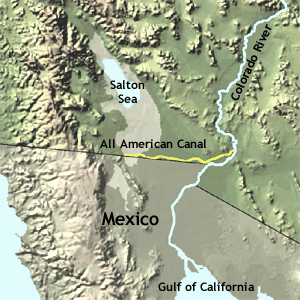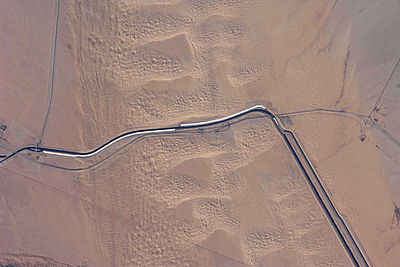All-American Canal
From Wikipedia, the free encyclopedia
Map showing the All-American Canal (yellow)
View of about 15 kilometers (9.3 mi) of the All-American Canal just west of
Yuma, Arizona.
Note: North is to upper-right.
All-American Canal near Algodones Road
The
All-American Canal is an 80-mile (130 km) long aqueduct, located in southeastern California. It conveys water from the
Colorado River into the
Imperial Valley and to nine cities. It is the Imperial Valley's only water source, and replaced the
Alamo Canal, which was located mostly in Mexico. The
Imperial Dam, about 30 miles (48 km) northeast of
Yuma, Arizona on the Colorado River, diverts water into the All-American Canal, which runs to just west of
Calexico, California
before its last branch heads mostly north into the Imperial Valley.
Five smaller canals branching off the All American Canal move water into
the Imperial Valley. These canal systems irrigate up to 630,000 acres
(250,000 ha) of good crop land and have made possible a greatly
increased crop yield in this area, originally one of the driest on
earth. It is the largest irrigation canal in the world,
[1] carrying a maximum of 26,155 cubic feet per second (740.6 m
3/s).
Agricultural runoff from the All American Canal drains into the
Salton Sea.
The All American Canal runs parallel to the Mexico California border
for several miles. With over 500 people having drowned in the canal
since 1997, it has been called "the Most Dangerous Body of Water in the
U.S."
[2]
History
The All-American Canal was authorized along with the
Hoover Dam by the 1928 Boulder Canyon Project Act and built in the 1930s by the
United States Bureau of Reclamation and
Six Companies, Inc..
[3] Its design and construction was supervised by the Bureau's then chief designing engineer,
John L. Savage and was completed in 1942.
[4]
Operations
Irrigation
The Bureau of Reclamation owns the canal, but the
Imperial Irrigation District operates it. Water for the canal is diverted at the
Imperial Diversion Dam. The All-American Canal feeds, from east to west, the
Coachella Canal,
East Highline Canal, Central Main Canal, and the Westside Main Canal.
These five main branches of the canal and a network of smaller canals
gradually reduce the flow of the All-American Canal until it ends at a
small drop in the western
Imperial Valley
where it drains into the Westside Main Canal. The main canal is 82
miles (132 km), with a total drop of 175 feet (53 m), a width of 150
feet (46 m) to 700 feet (210 m) and a depth of 7 feet (2.1 m) to 50 feet
(15 m) The canals get smaller as they run west because they carry less
water.
Power
Eight
hydroelectric power plants have been constructed along drops in the All-American Canal system. Drops 1 through 5,
Pilot Knob,
East Highline and Double Weir are located on the All-American Canal.
Another power plant, Turnip, is located on the Central Main Canal
branch. The power plants are all relatively small and have a combined
capacity of 58 MW. Electricity generation is dictated by water delivery
needs. There is also a 7.2 MW
pumped storage plant at Senator Wash Dam. Water from the Senator Wash Reservoir is released when water needs exceed flows at
Parker Dam.
Runoff
Runoff from the farmland irrigated by the All-American Canal make up most of the flows in the
Alamo River and
New River, both of which drain into the
Salton Sea, now providing most of its water.
[citation needed][5]
The rest is from smaller rivers and drainage systems. Historically, the
Salton Sea had been periodically flooded by extreme Colorado River
floods and usually dried up before being reflooded. If not for the
All-American Canal, the Salton Sea would have likely dried up long ago.
[citation needed]
The system transports silt, selenium and salts from the Colorado River
into the Salton Sea. Because there is no outlet to the ocean, these
salts and minerals are concentrated by evaporation.
[6]
Imperial dam, source of the water
A section of the canal, showing the steep concrete liner and a line of buoys added to prevent drowning
Straight section of canal
The All-American Canal Lining Project
Approximately 68,000 acre feet (84,000,000 m
3) was lost annually by seepage from the All-American Canal, especially from the point where the canal crosses the great
Algodones Dune Field. About 90% of this seepage entered Mexico.
[7]
At first this seepage caused widespread flooding, but Mexicali Valley
residents and businesses built drainage and pumping systems to recover
the seepage. Mexicali Valley agriculture became reliant upon this
seepage for irrigation.
[8]
As water use increased in both rural and urban areas, this seepage
became an issue of concern. The All-American Canal Lining Project, a
part of California’s Colorado River Water Use Plan, lined 37 kilometers
(23 mi) of the canal to prevent seepage.
[1]
In 2006, a Mexicali business and civic organization and two California
environmental non-profits challenged the lining project in US federal
court on the basis that it violated the water rights of Mexican water
users and violated US environmental statutes due to the seepage's
effects on the nearby Andrade Mesa Wetlands. A rider in the
Tax Relief and Health Care Act of 2006 required the completion of the lining project, however, and the lawsuit was rendered moot.
[9] The
Imperial Irrigation District
built a parallel canal along the designated section of the original
canal, and the water flow was rerouted into the new lined canal.
Construction began in 2007 and was completed in 2009.
[10]
Drowning deaths
Over 500 people have drowned in the All-American Canal since its
completion due to deep, cold water, steep sides that make escape
difficult, and swift currents that can reach 5.45 mph (8.8 km/h). Many
of those killed are migrants traveling across the U.S.-Mexico border.
Deaths peaked at 31 in 1998 after increased border security measures in
San Diego pushed migrants to cross the border in other areas. In 2011
the
Imperial Irrigation District
began installing lines with lifesaving buoys across the canal in 105
locations, despite debates about such safety measures encouraging
illegal migration. Bilingual signs reading "Warning: Dangerous Water"
were also installed in 1,414 locations along the canal. These safety
projects cost $1.1 million.
[11]
In popular culture
The canal was featured in the 1957 horror movie
The Monster That Challenged the World.
See also
References








No comments:
Post a Comment